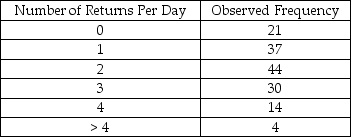THE NEXT QUESTIONS ARE BASED ON THE FOLLOWING INFORMATION:
A large department store records the number of returns per day in women's dresses for reasons such as wrong size;husband didn't like it,color,etc.The manager of the women's dresses department recalls from her statistics class in college that the Poisson distribution might describe such events.A random sample of 150 days is taken.The number of returns per day in the sample as well as the observed frequencies is shown in the table below:

She tests the hypothesis that returns per day are Poisson distributed with a population mean equal to 1.90.Her significance level is 0.05
-A random sample of 100 measurements of the resistance of electronic components produced in a period of 1 week was taken.The sample skewness was 0.60 and the sample kurtosis was 3.75.Test the null hypothesis that the population distribution is normal.
Definitions:
Consumer's Risk
The probability that a defective product will pass through a quality inspection process and reach the consumer.
Defects
Imperfections, faults, or flaws in a product or process that deviate from the desired specifications or standards.
C-chart
A control chart used for monitoring the number of defects per unit in manufacturing or production processes.
Control Limits
Statistical boundaries set within control charts in process control to identify whether a process is in a state of control.
Q7: Determine the sum of the median values
Q31: What is the coefficient of determination? What
Q71: Calculate the value of <img src="https://d2lvgg3v3hfg70.cloudfront.net/TB2968/.jpg" alt="Calculate
Q91: For a sample of 126 observations from
Q128: Is it possible to provide a meaningful
Q227: Compute the mean squares for regression.
Q228: Kurtosis is a statistic of a data
Q230: A goodness-of-fit-test is to be performed to
Q235: A random sample of 12 seniors in
Q246: Complete the missing values identified by asterisks